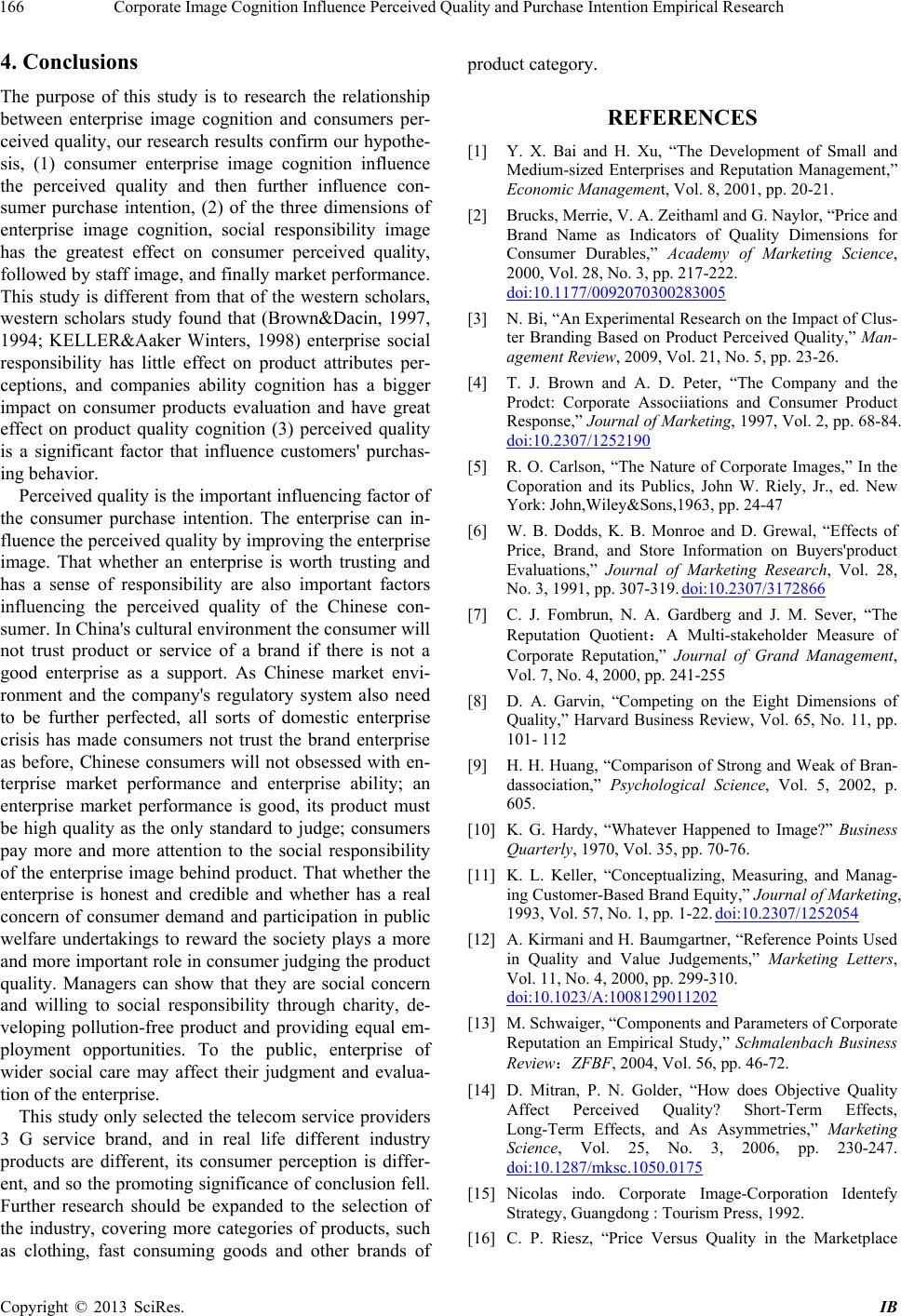
Corporate Image Cognition Influence Perceived Quality and Purchase Intention Empirical Research
166
4. Conclusions
The purpose of this study is to research the relationship
between enterprise image cognition and consumers per-
ceived quality, our research results confirm our hypothe-
sis, (1) consumer enterprise image cognition influence
the perceived quality and then further influence con-
sumer purchase intention, (2) of the three dimensions of
enterprise image cognition, social responsibility image
has the greatest effect on consumer perceived quality,
followed by staff image, and finally market performance.
This study is different from that of the western scholars,
western scholars study found that (Brown&Dacin, 1997,
1994; KELLER&Aaker Winters, 1998) enterprise social
responsibility has little effect on product attributes per-
ceptions, and companies ability cognition has a bigger
impact on consumer products evaluation and have great
effect on product quality cognition (3) perceived quality
is a significant factor that influence customers' purchas-
ing behavior.
Perceived quality is the important influencing factor of
the consumer purchase intention. The enterprise can in-
fluence the perceived quality by improving the enterprise
image. That whether an enterprise is worth trusting and
has a sense of responsibility are also important factors
influencing the perceived quality of the Chinese con-
sumer. In China's cultural environment the consumer will
not trust product or service of a brand if there is not a
good enterprise as a support. As Chinese market envi-
ronment and the company's regulatory system also need
to be further perfected, all sorts of domestic enterprise
crisis has made consumers not trust the brand enterprise
as before, Chinese consumers will not obsessed with en-
terprise market performance and enterprise ability; an
enterprise market performance is good, its product must
be high quality as the only standard to judge; consumers
pay more and more attention to the social responsibility
of the enterprise image behind product. That whether the
enterprise is honest and credible and whether has a real
concern of consumer demand and participation in public
welfare undertakings to reward the society plays a more
and more important role in consumer judging the product
quality. Managers can show that they are social concern
and willing to social responsibility through charity, de-
veloping pollution-free product and providing equal em-
ployment opportunities. To the public, enterprise of
wider social care may affect their judgment and evalua-
tion of the enterprise.
This study only selected the telecom service providers
3 G service brand, and in real life different industry
products are different, its consumer perception is differ-
ent, and so the promoting significance of conclusion fell.
Further research should be expanded to the selection of
the industry, covering more categories of products, such
as clothing, fast consuming goods and other brands of
product category.
REFERENCES
[1] Y. X. Bai and H. Xu, “The Development of Small and
Medium-sized Enterprises and Reputation Management,”
Economic Management, Vol. 8, 2001, pp. 20-21.
[2] Brucks, Merrie, V. A. Zeithaml and G. Naylor, “Price and
Brand Name as Indicators of Quality Dimensions for
Consumer Durables,” Academy of Marketing Science,
2000, Vol. 28, No. 3, pp. 217-222.
doi:10.1177/0092070300283005
[3] N. Bi, “An Experimental Research on the Impact of Clus-
ter Branding Based on Product Perceived Quality,” Man-
agement Review, 2009, Vol. 21, No. 5, pp. 23-26.
[4] T. J. Brown and A. D. Peter, “The Company and the
Prodct: Corporate Associiations and Consumer Product
Response,” Journal of Marketing, 1997, Vol. 2, pp. 68-84.
doi:10.2307/1252190
[5] R. O. Carlson, “The Nature of Corporate Images,” In the
Coporation and its Publics, John W. Riely, Jr., ed. New
York: John,Wiley&Sons,1963, pp. 24-47
[6] W. B. Dodds, K. B. Monroe and D. Grewal, “Effects of
Price, Brand, and Store Information on Buyers'product
Evaluations,” Journal of Marketing Research, Vol. 28,
No. 3, 1991, pp. 307-319. doi:10.2307/3172866
[7] C. J. Fombrun, N. A. Gardberg and J. M. Sever, “The
Reputation Quotient:A Multi-stakeholder Measure of
Corporate Reputation,” Journal of Grand Management,
Vol. 7, No. 4, 2000, pp. 241-255
[8] D. A. Garvin, “Competing on the Eight Dimensions of
Quality,” Harvard Business Review, Vol. 65, No. 11, pp.
101- 112
[9] H. H. Huang, “Comparison of Strong and Weak of Bran-
dassociation,” Psychological Science, Vol. 5, 2002, p.
605.
[10] K. G. Hardy, “Whatever Happened to Image?” Business
Quarterly, 1970, Vol. 35, pp. 70-76.
[11] K. L. Keller, “Conceptualizing, Measuring, and Manag-
ing Customer-Based Brand Equity,” Journal of Marketing,
1993, Vol. 57, No. 1, pp. 1-22. doi:10.2307/1252054
[12] A. Kirmani and H. Baumgartner, “Reference Points Used
in Quality and Value Judgements,” Marketing Letters,
Vol. 11, No. 4, 2000, pp. 299-310.
doi:10.1023/A:1008129011202
[13] M. Schwaiger, “Components and Parameters of Corporate
Reputation an Empirical Study,” Schmalenbach Business
Review:ZFBF, 2004, Vol. 56, pp. 46-72.
[14] D. Mitran, P. N. Golder, “How does Objective Quality
Affect Perceived Quality? Short-Term Effects,
Long-Term Effects, and As Asymmetries,” Marketing
Science, Vol. 25, No. 3, 2006, pp. 230-247.
doi:10.1287/mksc.1050.0175
[15] Nicolas indo. Corporate Image-Corporation Identefy
Strategy, Guangdong : Tourism Press, 1992.
[16] C. P. Riesz, “Price Versus Quality in the Marketplace
Copyright © 2013 SciRes. IB